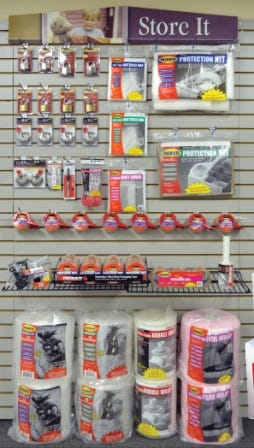When it comes to selling self-storage ancillary products like locks and boxes, operators should rely on the upsell technique. This proven sales method will add revenue and help operators deliver better customer service.
June 26, 2013

By Rob Kaminski
Its amazing how two nearly identical self-storage facilities in the same region can have such different results when it comes to selling ancillary products such as locks, boxes and tape. Why would one report consistently poor sales while the other rakes in twice as much cash or more? After conversing with a number of successful self-storage owners, Ive discovered their secret: retail upselling.
This is a sales technique whereby the seller induces the customer to purchase more expensive items, upgrades or other add-ons to make a more profitable sale. You may think this sounds similar to the old bait and switch method; but in reality, self-storage operators commonly upsell through bulk-discount offers and cross-selling. The intent and result is a better-served, more satisfied customer.
Drawing on input from some of the best self-storage retailers Ive met, here's how you can use retail sales to deliver better customer service and generate more revenue.
 Active Upselling Begins With a Smile
Active Upselling Begins With a Smile

Active selling requires action. Do your managers ask people who walk through the door if they can help them or, better yet, if theyre packing to store, move or ship something? Or do they say a quick hello and go back to whatever they were doing? The best upsellers often come out from behind the counter and approach the customer while conversing. The best selling (and upselling) is based on helpful customer service.
A lot of people have little knowledge of what packing supplies they need or even whats available. They may know theyll need some boxes but little else, so its the managers job to help them choose the right boxes, cushioning materials, tape, etc. If the customer chooses seven or eight of one box size and you discount bundles of 10, the manager should point that out. If you offer refunds on unused boxes, the managers can add that its a no risk decision. That, my friends, is upselling.
Know Your Product
Product knowledge is critical to successful upselling. Managers who are good at retail sales usually know their products and how theyre used. Theyve studied the product sales sheets and the training materials the supplier provided. If they ask the right questions, they can help clients choose items they would have never considered, such as stretch wrap or wardrobe boxes. They even know when and how to demonstrate these products. Managers who become skilled at upselling not only increase the average sale, they improve customer relations. Plus their self-confidence extends to rentals and the sale of other services at the facility.
Want to foster that kind of active selling? Provide your staff with training materials and product sales sheets. Quiz them informally from time to time. Or set up little contests so the best managers and best facilities get public recognition and, perhaps, some reward.
Passive UpSelling: Too Profitable to Pass Up
Passive upselling is inducing the customer to purchase more expensive items, upgrades or other add-ons to make a more profitable salewithout the assistance of a salesperson. Passive upselling relies on plan-o-gram displays, informational signage and demonstration product displays. It does much of what your actively upselling managers would do if they werent serving another customer or otherwise occupied.
Plan-o-grams are professional product arrangements designed to draw attention to your more profitable products while reminding customers of related products they may need. Good examples are markers, carton cutters, gloves, etc. Though these may not be the biggest sellers, they add visual appeal to your display and every one you sell is an upsell. Ideally, the plan-o-grams are based on the real-world experience of the suppliers self-storage client base. They should be available, free, from your retail supplier.
Signage is informational when it lists benefits or features to help the shopper make a buying decision. Picture a display of assembled boxes in small, medium and large sizes. Each has an eye-catching sign taped to it that explains its use. The small box, for example, might read, For heavy items such as books, dishes and tools. The words are just what a manager would have explained. If a loaded tape dispenser with its own sign (one roll will seal six boxes) were placed atop the box, you would have whats called informational cross-selling signage. Ask your supplier for more ideas like this.
Demonstration displays are used to show customers how they would use a product. A wardrobe boxs convenience is more convincing if one is displayed with some clothes hung on hangers in place. (Inexpensive clothes can be found at a Goodwill store or garage sale.) A small dresser with the drawers held in place with stretch wrap makes the point as well as any manager can. For other such ideas contact your retail product supplier
Finally, one collateral benefit of passive upselling is it serves to remind your managers what to say when theyre actively upselling. Through sales training, plan-o-gram product displays and informational signage, you can make upselling second nature in your facilities.
Rob Kaminski is the vice president of Supply Side USA, a supplier of retail products for the self-storage industry. He has helped self-storage owners improve their retail sales for more than 25 years. Hes written numerous articles on the subject and has also been a featured speaker on retail sales at national conferences and tradeshows. For more information, call 800.305.6110; e-mail [email protected]; visit www.supplysideusa.com .
You May Also Like





